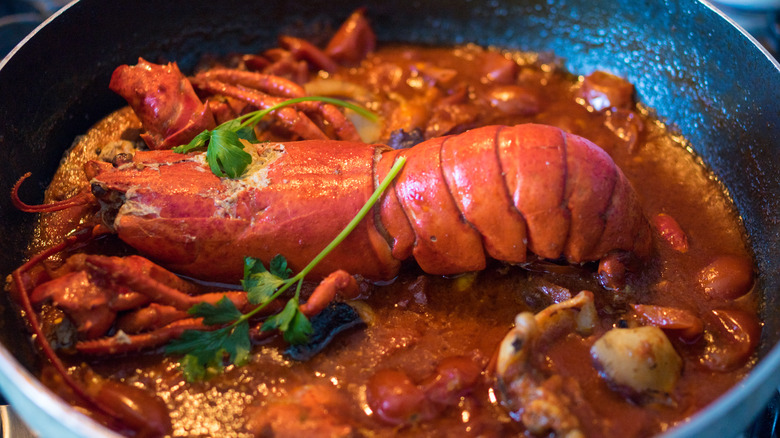Fra Diavolo Sauce's Name Has A Sinister Translation
If you're well versed in the wonderful world of Italian cuisine, you may recognize Fra Diavolo as the fiery red sauce with a wicked kick. Different from arrabbiata sauce (which is more like a punched-up marinara sauce), Fra Diavolo sauce is often flavored with Calabrian chiles, hint of brandy, and enhanced with the addition of shellfish — typically lobster or shrimp. Served over pasta, the sauce may sound like a heavenly combination of flavors. But the name Fra Diavolo has a rather menacing meaning.
Fra Diavolo translates to "Brother Devil," so it's easy to assume the dish's name refers to the hot-as-hellfire Calabrian chiles used to season it. However, various sources suggest that it's actually a nod to Michele Pezza, the infamous 18th-century Italian bandit turned guerilla revolutionary. After pulling through a devastating childhood illness, Pezza was known to dress like a monk to pay homage to St. Francis of Paola — a saint credited with raising a child from the dead.
In one version of events, people who witnessed Pezza's wild behavior when he was a boy gave him his sinister nickname. A different account claims that as an adult, he got the epithet from peasants impacted by his pillaging and murderous ways. Despite his devilish reputation (or perhaps, more accurately, because of it), Pezza was later used by the Naples government as a weapon against the threat of French occupation.
What's in a name?
Despite the ties to Italian history, Fra Diavolo sauce is believed to be an American-Italian creation although the specifics of where it was created remain something of a mystery. Italian cookbook author Anna Teresa Callen told the New York Times she thought the sauce might have been born on Long Island, while restaurant owner and Naples-native Tony May credited a restaurant in New York's midtown. One thing different people might agree on, however, was that it wasn't of Italian origin. "We don't even have American lobsters in Italy," cookbook author Giuliano Bugialli told the publication. "And a heavy tomato sauce with hot peppers, seafood, and pasta all in one dish is not Italian cooking."
While seafood and spicy red sauce may not be a typical Italian pairing, a chicken dish called Pollo alla Diavolo — seasoned in a similar fashion to Fra Diavolo — was featured in Pellegrino Artusi's 1891 cookbook, "Science in the Kitchen and the Art of Eating Well." However, Chef James Beard told the New York Times he believed the Fra Diavolo recipe was an American-Italian play on the French dish lobster a l'Americaine, which features a tarragon tomato sauce and lobster flambeed in cognac.

